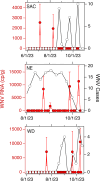West Nile Virus (Orthoflavivirus nilense) RNA concentrations in wastewater solids at five wastewater treatment plants in the United States
- PMID: 40718785
- PMCID: PMC12296570
- DOI: 10.7717/peerj.19748
West Nile Virus (Orthoflavivirus nilense) RNA concentrations in wastewater solids at five wastewater treatment plants in the United States
Abstract
Background: Orthoflavivirus nilense, formerly known as West Nile Virus (WNV), has become endemic to the United States since its introduction in 1999. Current surveillance methods rely primarily on mosquito pool testing, which is both costly and time-intensive. Wastewater-based epidemiology (WBE) has proven an effective method for the surveillance of various pathogens, including other orthoflaviviruses such as Dengue. WBE for WNV represents a potentially valuable surveillance approach that has so far been underexplored.
Methods: A targeted droplet digital reverse transcription-polymerase chain reaction (RT-PCR) approach (ddRT-PCR) was used to measure WNV concentrations in wastewater retrospectively from five locations and in over 600 samples. Three of these locations were in communities with multiple confirmed WNV infections, while two were not. Samples were collected during periods corresponding to typical WNV seasonality (spring to fall). SARS-CoV-2 RNA was measured simultaneously to assess nucleic acid degradation during sample storage. Publicly available confirmed WNV case data were compiled from the California and Nebraska departments of public health and their weekly arboviral reports.
Results: WNV RNA was detected in wastewater samples during periods of known viral circulation within a community. The adopted ddRT-PCR assay is highly specific and sensitive, and detections in wastewater solids correspond to the occurrence of cases in the season and location of sampling. WNV was detected in nine samples in three locations with known WNV clinical cases-wastewater positivity rates in these locations ranged from 3.3% to 13%. The results suggest that wastewater monitoring could serve as an effective complement to traditional surveillance methods, particularly for sentinel surveillance in locations which do not have extensive mosquito and clinical testing systems.
Keywords: Wasteater-based epidemiology; Wastewater; West Nile Virus.
©2025 Zulli et al.
Conflict of interest statement
Dorothea Duong and Bridgette Shelden are employees of Verily Life Sciences. Bradley White was an employee of Verily Life Sciences when this work was performed.
Figures



Similar articles
-
Re-Emergence of Usutu Virus and Spreading of West Nile Virus Neuroinvasive Infections During the 2024 Transmission Season in Croatia.Viruses. 2025 Jun 13;17(6):846. doi: 10.3390/v17060846. Viruses. 2025. PMID: 40573437 Free PMC article.
-
Laboratory-based molecular test alternatives to RT-PCR for the diagnosis of SARS-CoV-2 infection.Cochrane Database Syst Rev. 2024 Oct 14;10(10):CD015618. doi: 10.1002/14651858.CD015618. Cochrane Database Syst Rev. 2024. PMID: 39400904
-
Reconstructing the silent circulation of West Nile Virus in a Caribbean island during 15 years using sentinel serological data.PLoS Negl Trop Dis. 2025 Jun 23;19(6):e0012895. doi: 10.1371/journal.pntd.0012895. eCollection 2025 Jun. PLoS Negl Trop Dis. 2025. PMID: 40549806 Free PMC article.
-
Identification of West Nile virus infection by anti-premembrane antibodies in Nicaraguan children prior to 2007-2009.Microbiol Spectr. 2025 Jul;13(7):e0004725. doi: 10.1128/spectrum.00047-25. Epub 2025 May 22. Microbiol Spectr. 2025. PMID: 40401969 Free PMC article.
-
Signs and symptoms to determine if a patient presenting in primary care or hospital outpatient settings has COVID-19.Cochrane Database Syst Rev. 2022 May 20;5(5):CD013665. doi: 10.1002/14651858.CD013665.pub3. Cochrane Database Syst Rev. 2022. PMID: 35593186 Free PMC article.
References
-
- Boehm AB, Hughes B, Duong D, Chan-Herur V, Buchman A, Wolfe MK, White BJ. Wastewater concentrations of human influenza, metapneumovirus, parainfluenza, respiratory syncytial virus, rhinovirus, and seasonal coronavirus nucleic-acids during the COVID-19 pandemic: a surveillance study. The Lancet Microbe. 2023a;4:340–348. doi: 10.1016/S2666-5247(22)00386-X. - DOI - PMC - PubMed
-
- Borchardt MA, Boehm AB, Salit M, Spencer SK, Wigginton KR, Noble RT. The environmental microbiology minimum information (EMMI) guidelines: qPCR and dPCR quality and reporting for environmental microbiology. Environmental Science & Technology. 2021;55:10210–10223. doi: 10.1021/acs.est.1c01767. - DOI - PubMed
MeSH terms
Substances
LinkOut - more resources
Full Text Sources
Medical
Miscellaneous

